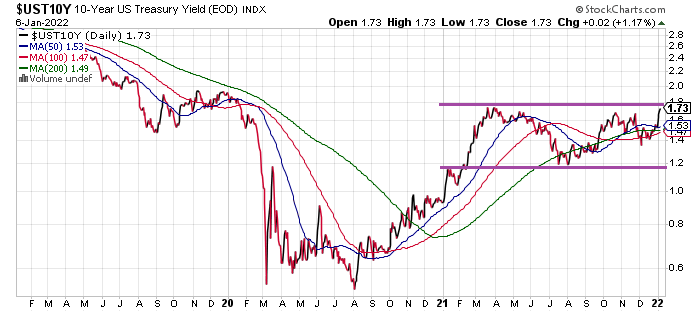10-Year Treasury Yield ‘Fair Value’ Estimate: Friday, Jan. 7
The US 10-year Treasury yield rose to a nine-month high on Thursday, Jan. 6, which may be a prelude to setting a new pandemic high in the days ahead. If that happens, the increase would signal a higher probability that the benchmark rate would push above levels reached before the pandemic started in early 2020. During the 12 months prior to pandemic, the 10-year rate traded in the roughly 2%-3%-plus range.
The catalyst: higher inflation and the Federal Reserve’s growing hawkish bias on monetary policy on three fronts: scaling down and then ending its bond-buying program; reducing the central bank’s balance sheet; and raising interest rates.
Fed minutes released earlier this week reported that in the mid-December FOMC meeting: “Almost all participants agreed that it would likely be appropriate to initiate balance sheet runoff at some point after the first increase in the target range for the federal funds rate.”
“The fact that almost all participants agreed that it was appropriate to initiate the balance sheet runoff after the first increase in the target range for the fed funds rate implies that there’s not a big appetite for ‘let’s wait and see,’” says Kathy Jones, chief fixed income strategist at Charles Schwab. “Last time, they waited two years. This time, it looks like they’re ready to go.”
The Treasury market appears to be pricing in these factors. The 10-year yield rose for a fourth straight day on Thursday, reaching 1.73%, a nine-month high, based on daily data via Treasury.gov. That’s just below the previous high: 1.74% on March 31, 2021. A substantial and sustained rise above these levels would likely be viewed in markets as a signal that rates would continue to rise/remain elevated for the near-term.
Fed funds futures are pricing in a roughly 92% probability that the central bank will leave its Fed funds target rate unchanged at a 0%-0.25% range in the upcoming Jan. 26 policy meeting. But the outlook shifts dramatically for the March FOMC announcement: futures estimate a 70%-plus probability for a rate hike on March 16, according to CME Group data.
Our average fair-value estimate for the 10-year yield (based on three models) continues to reflect a moderate gap between the actual and modeled rate – a gap that continues to suggest an upside bias for the market rate.
Today’s December estimate marks the seventh straight month that the market-based 10-year yield traded below our fair value estimate. Last month’s negative 59-basis-point negative gap implies a flat to moderately higher 10-year rate for the near-term.
Disclosures: None.






